|
 |
| Home
> All About
Bali > Dances & Drama |
| |
| Dances & Drama |
| |
 |
| |
Dance is the main art from Balinese
culture as well as the important part of nearly
every ritual in Bali. It is an integral part of
Balinese religion and culture. Dance is performed
at the main temple festivals and ceremonies of the
cycle of life and death.
Balinese dance goes as far back as Balinese written
history. With the exception of the trance dances,
much of the Balinese dance heritage originating
from Java.
Balinese dance can not be separated from religion.
Even dances for the tourists are always preceded
by a small offering of food and flowers. Before
performing, a dancer goes to pray at his family
shrine to beseech the holy inspiration from the
gods.
In the dance context, dance fulfills a number of
specific functions as: |
| • |
a channel for the visiting gods
or demonic gods, the dancers being then a
sort of living repository; these are the trance
dances, |
| • |
a welcome for the visiting gods, |
| • |
an entertainment for the visiting gods. |
|
| |
Besides its religious function,
dance and drama have also a religious content. Balinese
cultural memory has been transmitted through drama.
The episodes performed are usually relevant with
the rites taking place; during a wedding one performs
a wedding story, and at a death ritual a visit to
hell by the heroes.
Besides costumes, male and female roles are identified
mostly by the accentuation of the movements. Women’s
legs are bent and huddled together, the feet open,
so as to reveal a sensual arching of the back. While
the men, their legs are arched and their shoulders
pulled up, with sharper gestures, so as to give
the impression of power.
Dance movements come out of each other in a continuum
of gestures which has no break and no jumping -
except for some demonic or animal characters. The
expression is completed by mimicry of the face.
Even the eyes are dancing. |
| |
| Arja Dance-Drama |
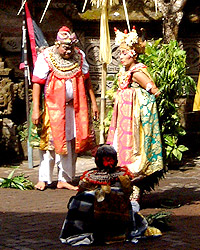 The
dialogue of the Arja consists of songs, so this
dance-drama is the Balinese dance-opera. Arja is
a very popular performance in Bali. In the past,
it used to be performed by men only, although the
main character is the princess. Nowadays, Arja dance-opera
is performed by women, except the clowns who are
played by men. The
dialogue of the Arja consists of songs, so this
dance-drama is the Balinese dance-opera. Arja is
a very popular performance in Bali. In the past,
it used to be performed by men only, although the
main character is the princess. Nowadays, Arja dance-opera
is performed by women, except the clowns who are
played by men.
Arja dance-drama developed around 1880 and its tragic
themes basically are derived from the classical
romances of the kingdoms of East Java-Kediri, Singasari
and Majapahit. Although Arja dance-drama is a favorite
among the villagers, it is difficult to follow for
those who cannot understand the clowns' translations.
Arja dance-opera is filled with sentimentality and
melodrama. Like so many great love stories, there
is always some tragic issue at stake between two
lovers such as their families prohibit the marriage,
a jealous rival makes war on the hero, the princess
is captured, the hero falls in love with another
woman while under a magic spell. There are always
long scenes of painful misery. After endless episodes
of intrigue and misfortune, the lovers are at last
reunited. |
| |
| Baris Dance |
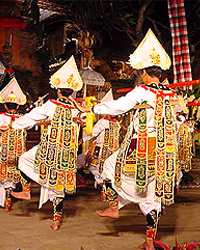 The
word Baris means line, in the sense of a line of
soldiers, and refers to the warriors who fought
for the kings of Bali. Baris dance is a solo warrior
dance which originally was a religious ritual dance,
the dedication of warriors and their weapons during
a temple feast. The
word Baris means line, in the sense of a line of
soldiers, and refers to the warriors who fought
for the kings of Bali. Baris dance is a solo warrior
dance which originally was a religious ritual dance,
the dedication of warriors and their weapons during
a temple feast.
The dancer must go through hard training to obtain
the skill and flexibility that symbolizes the courteous
style of the dance. The dancer must convey the characteristics
of a warrior such as fierceness, pride, alertness,
compassion, and regret. Baris dance is accompanied
by a gamelan orchestra, and the gamelan must be
entirely in tune to the changing moods of the warrior's
will. |
| |
| Barong Dance |
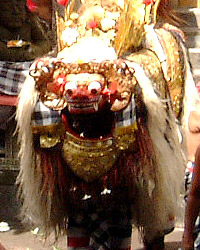 Barong
is probably the most well known dance. It is also
another story telling dance, narrating the fight
between good and evil. This dance is the classic
example of Balinese way of acting out mythology,
resulting in myth and history being blended into
one reality. Barong
is probably the most well known dance. It is also
another story telling dance, narrating the fight
between good and evil. This dance is the classic
example of Balinese way of acting out mythology,
resulting in myth and history being blended into
one reality.
The story is about Rangda, the mother of Erlangga,
the King of Bali in the 10th
century, who was condemned by Erlangga's father
because she practiced black magic. After she became
a widow, she summoned all the evil spirits in the
jungle, the leaks and the demons, to come after
Erlangga. A fight occurred, but she and her black
magic troops were too strong that Erlangga had to
ask for the help of Barong, the magical protector
of Balinese villages. Barong came with Erlangga's
soldiers, and fight ensued. Rangda casted a spell
that made Erlangga soldiers all wanted to kill themselves,
pointing their poisoned keris into their own stomachs
and chests. Barong casted a spell that turned their
body resistant to the sharp keris. At the end, Barong
won, and Rangda ran away.
The masks of Barong and Rangda are considered sacred
items. Before they are brought out, a priest must
be present to offer blessings by sprinkling them
with holy water taken from Mount Agung, and offerrings
must be presented.
The are several versions of the Barong Dance during
Galungan Kuningan festivals. There are Barong Ket,
Barong Asu (Dog Barong),
Barong Macan (Tiger Barong),
Barong Gajah (Elephant Barong),
Barong Bangkal (Pig Barong)
- wanders from door to door to cleanse the territory
of evil influences. |
| |
| Barong Landung |
Barong Landung is different from
other Barong dances in Bali. In Barong Landung,
the two dancers do not take the figure of animals,
but of the two giant puppets, a male and a female.
(Landung means tall).
The male giant barong is called Jero Gede (big
person) and the female giant barong is called
Jero Luh (female person).
Each barong is played by a man. Jero Gede has a
frightening black face, while Jero Luh has a comical
white or yellow face. Together they perform a comic,
opera sung in Balinese, with a story usually taken
from history.
Barong Landung is derived from the folktale. On
Nusa Penida Island, once lived an incestuous giant
demon, Jero Gede Mecaling. One day, he went to Bali
Island, followed by a horde of devils. He landed
in South Bali in the form of a barong and waited
there while the devils went inland to destroy. The
people frightened and consulted a priest who told
them to create another barong like Jero Gede Mecaling
to scare away the demon. The people then made a
big barong and succeeded in frightening the giant
demon back to Nusa Penida. Since then, the barong
has been used to exorcise illness and evil spirits.
Barong Landung is usually performed on Galungan
days, around Denpasar and Serangan Island. In Southern
Bali, Barong Landung is accompanied by smaller puppets
which play the roles of prince and princess. |
| |
| Calon Arang Dance |
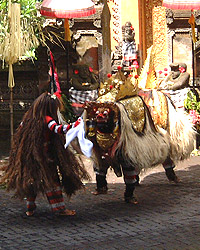 Calon
Arang Dance refers to the struggle between Rangda
(Calon Arang) and the
great king Airlangga. Calon Arang was a widow of
Girah who gave birth to a daughter in the jungle.
Her daughter grew up to be the famed beauty Ratna
Menggali. Calon Arang wanted her daughter to marry
a prince from Airlangga's palace. However, no prince
came along. Infuriated by this, Calon Arang learned
the art of black magic and practiced it against
the kingdom, causing many people to die. Calon
Arang Dance refers to the struggle between Rangda
(Calon Arang) and the
great king Airlangga. Calon Arang was a widow of
Girah who gave birth to a daughter in the jungle.
Her daughter grew up to be the famed beauty Ratna
Menggali. Calon Arang wanted her daughter to marry
a prince from Airlangga's palace. However, no prince
came along. Infuriated by this, Calon Arang learned
the art of black magic and practiced it against
the kingdom, causing many people to die.
When the king Airlangga heard of the epidemic in
Girah, he consulted his high priest, Mpu Bharadah.
The priest then sent his son to propose Ratna Menggali.
Calon Arang was pleased, the curse ended, and the
couple wed.
Calon Arang inscribed her black magic secret on
a lontar (palmleaf book).
One day, her son-in-law found it and gave it to
his father. When Calon Arang found out that Mpu
Bharadah had learned her secrets, she was furious
and declared war upon him. The priest had no choice
but to fight and, in a deadly struggle, destroyed
the widow by casting a spell. Before she died, Calon
Arang asked forgiveness. Mpu Bharadah forgave her
and showed her the way to heaven.
Before Calon Arang Dance is performed by midnight,
the audiences are gathered, listening to the Calon
Arang music, played by a full legong orchestra amplified
with large bamboo flutes. Offerings are made earlier
and consultations are held so as not to offend Rangda
(Calon Arang) and to
determine whether it is safe to perform the dance
which begins after midnight and lasts until dawn. |
| |
| Cekepang Dance |
Cekepang dance is originated from
Eastern Bali and rarely performed outside Karangasem
region. This dance is still performed in some regions
in Lombok, a heritage of the days when Lombok was
ruled by the kings of Karangasem.
Cekepang dance tells a story of Arjuna Wiwaha, a
classical Hindu literature. The song, music, dance
and costume of Cekepang are spectacular. |
| |
| Cupak Dances |
Cupak is an old Balinese dance drama,
which was originated from Kediri Kingdom of East
Java. Although it is performed as a comic opera,
Cupak dance is really an epic tale of jealousy,
heroic actions, and betrayal.
The main character is a greedy man who has a huge
belly named Cupak and his handsome younger brother,
Grantang. One day, the beloved daughter of the king
of Kediri, Mustikaning Daha, has been kidnapped.
The king announces that whoever finds her daughter
may become king. Cupak and Grantang determine to
look for her.
A monkey informed the brothers that the princess
is kidnapped by a witch who likes to eat flesh.
Led by the monkey, Cupak and Grantang go into the
dark forest.
They meet the witch and the fight follows. In the
battle, Grantang, the princess, and the witch all
fall into a well. Grantang defeats the witch, but
just as Grantang is about to come out of the well,
Cupak pulls the rope, saving the princess but letting
his brave brother fall back into the well.
Cupak then goes to Kediri to tell the king how he
himself killed the witch and rescued the princess.
The king offers Cupak whatever he would like. Cupak
of course asks for food: two mounds of rice and
one suckling pig which he eats all himself.
In the meantime, Grantang manages to climb out of
the well on a ladder made from the witch's bones.
He meets Cupak, but Cupak refuses to recognize him
and has him thrown into the sea. Grantang is saved
by a fisherman who takes care of him to health.
Before Cupak is about to be crowned as king, Grantang
challenges him to a fight. Grantang defeats Cupak
easily that leads him to wed the princess. |
| |
| Drama Gong |
| This popular dance-drama was created
in the late 1960s. In Drama Gong, acting is the
most important part while music and dance are downplayed.
This dance-drama is the occasion for the Balinese
people to socialize, therefore, Drama Gong has become
more popular than Arja Dance. |
| |
| Gambuh |
In the past, the sacred Gambuh dance
was performed at ceremonies, usually in the kingdom's
central pavilion or the center yard of a temple.
Prior to the performance, respects are paid to the
gods in order to ensure a smooth and successful
show.
The gambuh is the oldest classical dance of Bali.
This dance is known as a tribute to the king's relatives.
The gambuh drama is about the adventures of Panji’s
search for his lost beloved across the kingdoms
of Eastern Java. Its movements reflect the dances
from Hindu Java in the reign of Majapahit Empire,
characterized by particular eye movements, a typical
feature of Balinese dance in the pre-Hindu era.
The artistry of the Gambuh is enhanced by a gamelan
pegambuhan orchestra, dominated by the sound of
bamboo flute. |
| |
| Gebug Ende (War
Dance) |
Gebug Ende which means beating the
shield (ende) is usually
performed by two to sixty male dancers who dance
and fight in pairs. Each dancer carries a long rattan
stick as a weapon and a shield (ende).
During the performance, the two dancers try to beat
one another with the rattan stick while using ende
to protect themselves.
Gebug Ende is quite unique as it has certain rules
that have to be followed by the contestants. Led
by a jury, this dance starts with two dancers, while
the rest sit in a circle, cracking jokes and singing,
while waiting their turns. The jury decides which
of the two contestants loses the game and has to
leave the stage. Then, the next dancers will be
called up to the stage. This continues until all
have had a turn. Sometimes the fight becomes very
fierce and the dancers get thrown of the stage.
Bruises and wounds are common in this dance. |
| |
| Ghopala Dance |
Ghopala dance was created in 1984
and usually performed by five youngster dancers.
The dance portrays the world of children herdsmen
who joyfully meet and play along the boundaries
of rice fields while tending their cows.
Their lives are filled with happiness as they dance
and play in a way which highlights their individual
characters. They never tire of their duties as herdsmen,
devotedly defending the lives of their cattle. |
| |
| Janger Dance |
Janger Dance is a folk dance which
was introduced to Bali in the 30’s. The dance
starts with two girl singers who appear on the stage
wearing beautiful, floral crowns. They move forward,
allowing another pair to enter, until twelve girls
have filled on stage. Slowly, they kneel opposite
each other, cocking their heads and darting their
eyes to accent the rhythm of the orchestra.
As the singing continues, twelve young men silently
repeat the girls' entrance with deliberate and strong
movements. All men have painted moustaches and bear
the self assured look of an aristocrat. During the
dance, all the men move aggressively with quick
shouts of "O beh! O beh!
Dinga dinga ding janger-ger!" while
the women sing and sway from side to side. |
| |
| Jauk Dance |
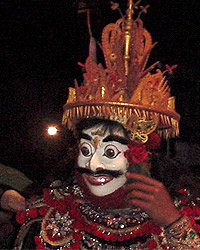 Jauk
Dance is a classical solo mask dance dated from
the 18th century,
in which the dancer wears fearsome mask of the raksasa
(giant) or demon. The
dance played episodes from the Ramayana and Mahabharata
epics in the old Kawi language. Jauk
Dance is a classical solo mask dance dated from
the 18th century,
in which the dancer wears fearsome mask of the raksasa
(giant) or demon. The
dance played episodes from the Ramayana and Mahabharata
epics in the old Kawi language.
The dancer's aim is to express the character revealed
in the appearance of the mask that of a strong,
forceful personality. The Jauk dancer's demonic
mask is colored a violent red, or sometimes white,
with thick black moustache, bulging eyes, and an
eerie smile. As his whole face is covered by a frightening
mask, the Jauk dancer must convey his emotions solely
through his movements and gestures.
Other characteristics of the costume are gloves
with long nails and high headdress with colorful
pompoms and decoration. Jauk dancer's movements
are very much similar to Baris dance, but the manner
is more exaggerated and violent. |
| |
| Joged Dance |
The Joged dance is typically accompanied
by a gamelan ensemble of bamboo instruments called
a gamelan joged bumbung. The Joged Bumbung is one
of the few secular dances of Bali where the flashy-dressed
jogged dancer invites men from the crowd to dance
with her in pretence of seduction.
The dance begins with a long opening sequence of
the female dancer. With her long shawl in the hand,
she goes among the spectators and invites a man
by pointing at him with her fan, or touching him
at the waist. The man invited to dance is called
the pengibing. The better he is, the louder the
cheers and roar of the crowd. He may try to pinch
her, dance hip to hip with her, or behave like an
upset lover and try to hit her. |
| |
| Kebyar Dances |
The Kebyar dance is a male solo
dance. Among the most famous Kebyar dance are the
Kebyar Duduk and Kebyar Trompong. These two dances
were created by Mario, the Balinese dance genius
of the century.
The most popular Kebyar is Kebyar Duduk where the
dancer sits cross-legged throughout most of the
dance. As the dance progresses, the dancer crosses
the floor on the outer edges of his feet and approaches
a member of the orchestra.
In order to become a great Kebyar dancer, he has
to be able to play every instrument of the orchestra.
In Kebyar Trompong, the dancer joins the orchestra
by playing a long instrument called the trompong
while dancing. |
| |
| Kecak Dance |
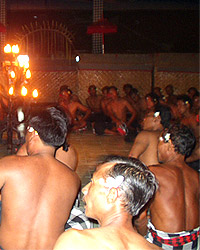 Kecak
dance is perhaps the most stunning of all the Balinese
dances. The story line of the dance is taken from
the Hindu epic Ramayana that tells the story of
Prince Rama and his rescue of Princess Sinta, who
has been kidnapped by the evil King Rahwana. Prince
Rama was able to rescue Princess Sinta with the
help of the white monkey armies. Kecak
dance is perhaps the most stunning of all the Balinese
dances. The story line of the dance is taken from
the Hindu epic Ramayana that tells the story of
Prince Rama and his rescue of Princess Sinta, who
has been kidnapped by the evil King Rahwana. Prince
Rama was able to rescue Princess Sinta with the
help of the white monkey armies.
The word Kecak is derived from the "chak-chak"
sounds, the chanting 'monkey' chorus. Unlike other
dances, there is no gamelan orchestra accompanying
it. Instead, a group of over 150 bare-chested men
make an amazing synchronized chak-chak sound while
swaying their bodies and waving their hands, acting
as the various monkey armies that are featured in
the story. |
| |
| Legong Kraton |
In legends, Legong is the heavenly
dance of divine nymphs. Of all classical Balinese
dances, it remains the quintessence of femininity
and grace. The most popular Legong dance is Legong
Kraton (Legong of the Palace).
Formerly, the dance was patronized by local kings
and held in a residence of the royal family. Dancers
were recruited from the aptest and prettiest children.
Today, the Legong dancers are still very young.
The dance is performed by three dancers: a female
attendant of the palace and two identically dressed
legongs who act the roles of royal persons. The
story derives from the history of East Java in the
12th and 13th
centuries. A king finds the maiden Rangkesari lost
in the forest. He takes her home and locks her in
a house of stone. Rangkesari's brother, the Prince
of Daha, threatens war unless she is set free.
Rangkesari begs her captor to avoid war by giving
her liberty, but the king prefers to fight. On his
way to battle, he encounters a bird of ill omen
that predicts his death. In the fight that ensues
he is killed. The dance dramatizes the farewells
of the King as he departs for the battlefield and
his ominous encounter with the bird.
The dancers flow from one identity into the next
without disrupting the harmony of the dance. They
may act as the double image of one character and
their movements marked by tight synchronization.
Then they may split, each enacting a separate role,
and come together again. In a love scene in which
they rub noses, the King takes leave of Rangkesari.
She repels his advances by beating him with her
fan, and he departs in anger, soon to perish on
the battlefield. |
| |
| Mendet Dance |
Mendet dance is a sacred processional
dance which is performed in the inner sanctums of
the temple by the married women of the village,
though in some cases young women and girls join
in as well.
The women carry offerings of arak (traditional
liquor) and holy water to offer up to the
Gods on their divine journey home. A procession
is formed and the women weave around the temple
grounds in stylized patterns to the gong music,
stopping in front of each shrine to offer up their
offerings. |
| |
| Oleg Tambulilingan Dance |
Oleg Tambulilingan Dance was created
by I Mario of Tabanan in 1952. The dance was originally
performed by one girl and called Oleg which means
the swaying of a dancer. Later, a male part was
added to make it a duet, and the dance had a new
theme portraying two bumblebees (Tambulilingan)
flirting in a flower garden.
The female dancer enters the stage first, circling
the stage in tight quick steps, trailing a long
silk scarf. The dancer portrays the full range of
female emotions: seductiveness, scorn, teasing,
moodiness, naughtiness, happy. The female dancer
first pretends to snub the male, but he is finally
able to win her love by various tactics.
In one sequence, the female dancer dances in the
seated position while she sensuously sways and waves
her hands. The male dancer circles her with a manly
pace, his head cocked, feeling his power over her.
They come close, only to swirl apart again. Oleg
Tambulilingan dance ends with a love dance of the
two bumblebees. |
| |
| Panyembrama |
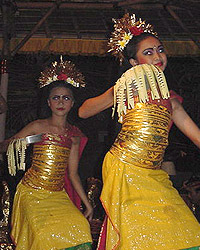 These
dances are performed as a welcome to the visiting
gods, which are presented with offerings of flowers.
Nowadays, the showering of flowers is also addressed
to the tourists. During the dance, the flowers are
scattered over the guest or audience as an expression
of welcome. These
dances are performed as a welcome to the visiting
gods, which are presented with offerings of flowers.
Nowadays, the showering of flowers is also addressed
to the tourists. During the dance, the flowers are
scattered over the guest or audience as an expression
of welcome.
The Panyembrama has taken many of its movements
from temple dances, such as the Rejang Dance, Pendet
and Gabor, which are considered sacred and performed
exclusively for God. |
| |
| Prembon Dance |
Prembon dance was created in the
1940s by the royal dancers of Gianyar Palace under
command of the king of Gianyar, I Dewa Manggis VIII.
The dance took movements from Arja, Baris, Gambuh,
Parwa, and mainly Topeng Dance, an excellent performance
to a whole range of different dances.
Prembon dance often begins with a solo Baris dance
and other non-dramatic dance, followed by a story
of Balinese kings with characters from Arja, Baris,
Gambuh, Parwa, and Topeng Dance. Although Prembon
has a resemblance to Topeng performance, but watching
Prembon gives an excellent glimpse of all dance
genres above. |
| |
| Ramayana Dance |
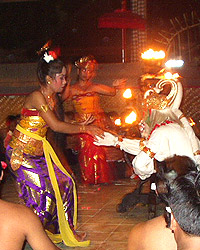 A
new version of Ramayana dance was introduced to
Bali in mid 1970s. Accompanied by the gamelan gong
orchestra, Ramayana dance is a unique combination
of traditional dance technique and modern comedy. A
new version of Ramayana dance was introduced to
Bali in mid 1970s. Accompanied by the gamelan gong
orchestra, Ramayana dance is a unique combination
of traditional dance technique and modern comedy.
The scene begins in the deep forest of Dandaka where
Prince Rama, his wife Sita, and his brother Laksmana
live peacefully in exile. One day, while hunting
for deer, Sita is kidnapped by the evil Rawana.
With the help of Garuda and a white monkey general
named Hanuman, Prince Rama eventually rescues his
wife.
Because of their ideal good looks, the characters
of Rama and Laksmana are played by beautiful women.
Rama wears a golden headgear while Laksmana wears
a black headdress. Their dancing style is very refined
and dignified as noble characters.
On the other hand, the demon king, Rawana, is arrogant
and bad-tempered. His dancing style is more in keeping
with a demon character. Often, it is the animals
of Ramayana dance who steal the show as they have
more freedoms than human character. Therefore, Hanuman
is usually played by the most creative actor. Each
performance of Hanuman will never be the same. |
| |
| Rejang Dance |
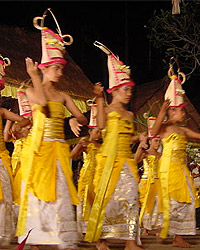 Rejang
dance is a sacred temple dance which is performed
as an offering to the Gods who have momentarily
visited a shrine. The dance is performed by women
of all ages to propitiate ancestral spirits. Rejang
dance is a sacred temple dance which is performed
as an offering to the Gods who have momentarily
visited a shrine. The dance is performed by women
of all ages to propitiate ancestral spirits.
The dance’s steps and gestures are simple.
The dancers move slowly and deliberately to the
padmasana (shrine),
holding their hip sashes and twirling their fans |
| |
| Sanghyang Dedari Dance |
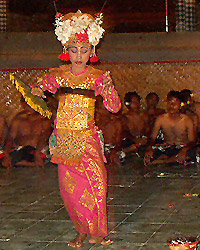 Sanghyang
Dedari is a ceremonial dance which is performed
to repel the evil spirit and stop them from infecting
the people in the form of sickness or death. Dedari
means angel and the dance is a means of contact
with the spirit world in which the dancers become
the mediums. Sanghyang
Dedari is a ceremonial dance which is performed
to repel the evil spirit and stop them from infecting
the people in the form of sickness or death. Dedari
means angel and the dance is a means of contact
with the spirit world in which the dancers become
the mediums.
Sanghyang Dedari is performed by two girl dancers
who are put into trance before dancing. They dance
in perfect harmony to the background of male kecak
choir, although their eyes never open during the
entire performance. When the chant ends, the girl
dancers fall down into the ground. Then, they are
brought out from trance by a priest (Pemangku),
who prays beside them and blesses them with holly
water. |
| |
| Sanghyang Jaran Dance |
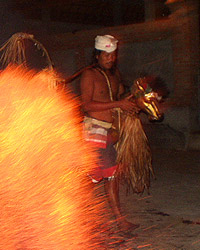 Sanghyang
Jaran dance is performed by a man dancer who tramples
on flaming coals riding a hobby horse made out of
palm leaves. The red hot coals are scattered, and
the dancer trances like a horse, snorting and neighing,
seemingly unscathed by his torment. Sanghyang
Jaran dance is performed by a man dancer who tramples
on flaming coals riding a hobby horse made out of
palm leaves. The red hot coals are scattered, and
the dancer trances like a horse, snorting and neighing,
seemingly unscathed by his torment.
The dance is believed to have the power to invite
the gods or sacred spirits to enter the body of
the dancers and put them in a state of trance. It
dates back to the ancient Pre-Hindu culture, a time
when Balinese people strongly believed that a dance
could cure sickness and disease. Sanghyang Jaran
dance is usually performed in the fifth or sixth
month of Balinese calendar as it is believed that
during these months, Balinese people are vulnerable
to all kinds of illnesses. |
| |
| Semarayana Dance |
Semarayana dance was created in
1994 with the main character, Dewi Chandra Kirana,
a princess from Daha Kingdom who disguised herself
as a male youth so she could venture out and seek
her beloved who had disappeared without a trace.
By wearing a headdress (destar),
the symbol of manhood, and with shoulder length
hair, the princess was unrecognizable as a female.
She finally meets her beloved but due to her disguise
and the fact that he is partly obscured when they
meet, a fight develops.
In the fight, the princess's destar is knocked from
her head and her beloved, Raden Inu Kertapati, recognizes
her and rushes to her side to embrace her. |
| |
| Topeng (Mask)
Dance |
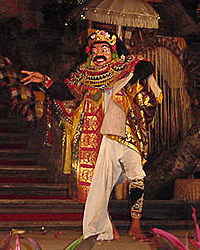 The Topeng dance is about the stories of Balinese
and Javanese ancestors. The dancers have to imitate
each character represented by the mask. As a ritual
interval in religious ceremonies and processions,
the Topeng dance ultimately takes on a sacred connotation.
As a matter of fact, foreigners are allowed to see
the dance only if they behave appropriately and
respectfully.
The Topeng dance is about the stories of Balinese
and Javanese ancestors. The dancers have to imitate
each character represented by the mask. As a ritual
interval in religious ceremonies and processions,
the Topeng dance ultimately takes on a sacred connotation.
As a matter of fact, foreigners are allowed to see
the dance only if they behave appropriately and
respectfully.
Peculiar components of the Topeng dance are the
masks used to hide the faces of the dancers. Specific
attributes are used to identify the characters,
such as: a mustache and thick eyebrows for the elder,
arrogance and defiance for Patih, etc. The rhythm
of movements, in accordance to the age and role
of the character, is underscored by a large gamelan
orchestra. |
| |
| Trunajaya Dance |
Trunajaya dance was created by Wayan
Wandres, who was originally from Singaraja, Buleleng,
North Bali. The word Trunajaya is derived from Truna
which means single and Jaya which means to win.
The dance which portrays the emotions of a young
man through love and passion, is generally performed
by a young woman who wears a headdress (destar)
and a loincloth (kancut).
Trunajaya dance is usually performed by a single
female but sometimes two, dancing together in synchronous
movements and to the mesmerized sounds of Gong Kebyar,
a fast rhythmic beat which goes in harmony to the
dance. |
| |
| Wayang (Shadow
Puppet Show) |
The wayang (shadow
puppet) show is perhaps the most famous Balinese
theater. The wayang show is the door to Bali’s
unique world of myths, symbols and religious beliefs.
The dalang (puppet master)
tells the story by projecting on a white screen,
the shadows of the puppets he manipulates in front
of a big oil lamp. He plays several characters at
once, singing and hitting his puppet box to mark
the rhythm.
The dalang takes his narrative from the great epics
of the Mahabharata, Ramayana, and other stories.
He then creates his own episodes, usually about
a hero’s quest for a magical weapon, a godly
secret, or a mate. The hero, accompanied by buffoons,
eventually succeeds after long adventures in the
wilderness and fighting against evil giants. There
are two sets of puppets, those of the right for
the heroes, and those of the left for the villains,
symbolize the internal fight of good and evil. |
| |
| Yudapati Dance |
Yudapati dance was created in 1987,
based on Baris dance. The word Yudapati is derived
from Yuda which means war and Pati which means death.
Yudapati is a dance which portrays a warrior about
to embark on a battle. Although the dancers are
sometimes men, it is generally women who perform
the dance, dressed in male costumes and headdresses.
The reason why the dance is performed by female
dancers is that the choreographer wishes to expose
all the delicate gestures and movements in the dance
by using the flexibility of a woman's body.
Yudapati dance was originally performed for religious
purposes but nowadays is performed regularly as
a tourist attraction. |
| |
|
 |
|
|
